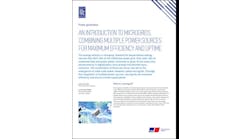New Jersey Offers Initial $65M from Resilience Bank for Microgrids at Water Plants
The New Jersey Energy Resilience Bank (ERB) is now accepting applications for microgrids and other distributed energy resources at critical facilities throughout the state.
The public infrastructure bank will use $200 million in federal disaster relief funds to finance projects.
The resilience bank will initially offer financing for distributed energy projects at water and wastewater treatment plants. It is now accepting applications for $65 million allotted for these facilities.
The application period for water and wastewater treatment facilities will be followed by a similar process for other critical sectors, such as healthcare, education, and transit.
Superstorm Sandy caused extensive damage to New Jersey’s energy infrastructure, disrupting delivery of electricity, petroleum, and natural gas to consumers across the state, and leaving an estimated five million residents without electricity. Distributed energy resources, including combined heat and power, fuel cells and off-grid solar inverters with battery storage, allowed some critical facilities, such as hospitals, wastewater treatment plants and universities, to remain operational while the electric grid was down.
Learn more about how buildings with microgrids fare during power outages. Download our new, free guide: The Energy Efficient Microgrid.
In addition to providing resilience, istributed energy resource can lower and stablize energy costs, reduce emissions and increase overall energy efficiency.
The resilience bank will offer grants and forgivable loans to address up to 40 percent of unmet funding needs. Low-interest, amortizing loans will be available for the remaining 60 percent. Grants and loans may require equity contribution, and any principal forgiveness component will require evidence of meeting minimum performance requirements.
Eligible technologies must be able to island, start up without a direct connection to the electric grid (blackstart), and have the capability to operate at critical load.
The resilience bank is the result of collaboration between the NJ Board of Public Utilities (BPU) and the NJ Economic Development Authority (EDA)
For eligibility requirements see the ERB Program Guide to Program Funds and the Round One funding document at www.NJERB.com, or call (866) 534-7789, or email [email protected].
Keep up on microgrid funding opportunities by subscribing to the free Microgrid Knowledge newsletter.






